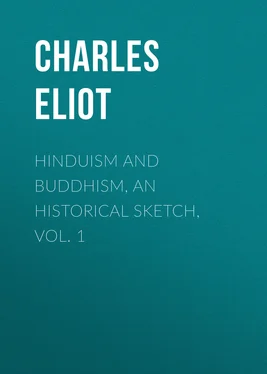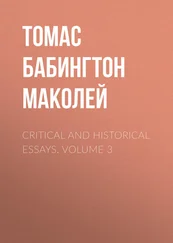Charles Eliot - Hinduism and Buddhism, An Historical Sketch, Vol. 1
Здесь есть возможность читать онлайн «Charles Eliot - Hinduism and Buddhism, An Historical Sketch, Vol. 1» — ознакомительный отрывок электронной книги совершенно бесплатно, а после прочтения отрывка купить полную версию. В некоторых случаях можно слушать аудио, скачать через торрент в формате fb2 и присутствует краткое содержание. Жанр: foreign_religion, Философия, Религиозная литература, foreign_psychology, foreign_antique, foreign_prose, на английском языке. Описание произведения, (предисловие) а так же отзывы посетителей доступны на портале библиотеки ЛибКат.
- Название:Hinduism and Buddhism, An Historical Sketch, Vol. 1
- Автор:
- Жанр:
- Год:неизвестен
- ISBN:нет данных
- Рейтинг книги:5 / 5. Голосов: 1
-
Избранное:Добавить в избранное
- Отзывы:
-
Ваша оценка:
- 100
- 1
- 2
- 3
- 4
- 5
Hinduism and Buddhism, An Historical Sketch, Vol. 1: краткое содержание, описание и аннотация
Предлагаем к чтению аннотацию, описание, краткое содержание или предисловие (зависит от того, что написал сам автор книги «Hinduism and Buddhism, An Historical Sketch, Vol. 1»). Если вы не нашли необходимую информацию о книге — напишите в комментариях, мы постараемся отыскать её.
Hinduism and Buddhism, An Historical Sketch, Vol. 1 — читать онлайн ознакомительный отрывок
Ниже представлен текст книги, разбитый по страницам. Система сохранения места последней прочитанной страницы, позволяет с удобством читать онлайн бесплатно книгу «Hinduism and Buddhism, An Historical Sketch, Vol. 1», без необходимости каждый раз заново искать на чём Вы остановились. Поставьте закладку, и сможете в любой момент перейти на страницу, на которой закончили чтение.
Интервал:
Закладка:
The preservation of a very ancient form of Buddhism in Ceylon 32 32 The Buddhism of Siam and Burma is similar but in Siam it is a mediæval importation and the early religious history of Burma is still obscure.
is truly remarkable, for if in many countries Buddhism has shown itself fluid and protean, it here manifests a stability which can hardly be paralleled except in Judaism. The Sinhalese, unlike the Hindus, had no native propensity to speculation. They were content to classify, summarize and expound the teaching of the Pitakas without restating it in the light of their own imagination. Whereas the most stable form of Christianity is the Church of Rome, which began by making considerable additions to the doctrine of the New Testament, the most stable form of Buddhism is neither a transformation of the old nor a protest against innovation but simply the continuation of a very ancient sect in strange lands 33 33 Although stability is characteristic of the Hinayana its later literature shows a certain movement of thought phases of which are marked by the Questions of Milinda, Buddhaghosa's works and the Abhidhammattha Sangaha.
. This ancient Buddhism, like Islam which is also simple and stable, is somewhat open to the charge of engaging in disputes about trivial details 34 34 E.g. the way a monastic robe should be worn and the Sîmâ.
, but alike in Ceylon, Burma and Siam, it has not only shown remarkable persistence but has become a truly national religion, the glory and comfort of those who profess it.
11. Rebirth and the Nature of the Soul
The most characteristic doctrine of Indian religion—rarely absent in India and imported by Buddhism into all the countries which it influenced—is that called metempsychosis, the transmigration of the soul or reincarnation. The last of these terms best expresses Indian, especially Buddhist, ideas but still the usual Sanskrit equivalent, Saṃsâra , means migration. The body breaks up at death but something passes on and migrates to another equally transitory tenement. Neither Brahmans nor Buddhists seem to contemplate the possibility that the human soul may be a temporary manifestation of the Eternal Spirit which comes to an end at death—a leaf on a tree or a momentary ripple on the water. It is always regarded as passing through many births, a wave traversing the ocean.
Hindu speculation has never passed through the materialistic phase, and the doctrine that the soul is annihilated at death is extremely rare in India. Even rarer perhaps is the doctrine that it usually enters on a permanent existence, happy or otherwise. The idea underlying the transmigration theory is that every state which we call existence must come to an end. If the soul can be isolated from all the accidents and accessories attaching to it, then there may be a state of permanence and peace but not a state comparable with human existence, however enlarged and glorified. But why does not this conviction of impermanence lead to the simpler conclusion that the end of physical life is the end of all life? Because the Hindus have an equally strong conviction of continuity: everything passes away and changes but it is not true to say of anything that it arises from nothing or passes into nothing. If human organisms (or any other organisms) are mere machines, if there is nothing more to be said about a corpse than about a smashed watch, then (the Hindu thinks) the universe is not continuous. Its continuity means for him that there is something which eternally manifests itself in perishable forms but does not perish with them any more than water when a pitcher is broken or fire that passes from the wood it has consumed to fresh fuel.
These metaphors suggest that the doctrine of transmigration or reincarnation does not promise what we call personal immortality. I confess that I cannot understand how there can be personality in the ordinary human sense without a body. When we think of a friend, we think of a body and a character, thoughts and feelings, all of them connected with that body and many of them conditioned by it. But the immortal soul is commonly esteemed to be something equally present in a new born babe, a youth and an old man. If so, it cannot be a personality in the ordinary sense, for no one could recognize the spirit of a departed friend, if it is something which was present in him the day he was born and different from all the characteristics which he acquired during life. The belief that we shall recognize our friends in another world assumes that these characteristics are immortal, but it is hard to understand how they can be so, especially as it is also assumed that there is nothing immortal in a dog, which possesses affection and intelligence, but that there is something immortal in a new born infant which cannot be said to possess either.
In one way metempsychosis raises insuperable difficulties to the survival of personality, for if you become someone else, especially an animal, you are no longer yourself according to any ordinary use of language. But one of the principal forms taken by the doctrine in India makes a modified survival intelligible. For it is held that a new born child brings with it as a result of actions done in previous lives certain predispositions and these after being developed and modified in the course of that child's life are transmitted to its next existence.
As to the method of transmission there are various theories, for in India the belief in reincarnation is not so much a dogma as an instinct innate in all and only occasionally justified by philosophers, not because it was disputed but because they felt bound to show that their own systems were compatible with it. One explanation is that given by the Vedânta philosophy, according to which the soul is accompanied in its migrations by the Sûkshmaśarîra or subtle body, a counterpart of the mortal body but transparent and invisible, though material. The truth of this theory, as of all theories respecting ghosts and spirits, seems to me a matter for experimental verification, but the Vedânta recognizes that in our experience a personal individual existence is always connected with a physical substratum.
The Buddhist theory of rebirth is somewhat different, for Buddhism even in its later divagations rarely ceased to profess belief in Gotama's doctrine that there is no such thing as a soul—by which is meant no such thing as a permanent unchanging self or âtman . Buddhists are concerned to show that transmigration is not inconsistent with this denial of the âtman . The ordinary, and indeed inevitable translation of this word by soul leads to misunderstanding for we naturally interpret it as meaning that there is nothing which survives the death of the body and a fortiori nothing to transmigrate. But in reality the denial of the âtman applies to the living rather than to the dead. It means that in a living man there is no permanent, unchangeable entity but only a series of mental states, and since human beings, although they have no âtman , certainly exist in this present life, the absence of the âtman is not in itself an obstacle to belief in a similar life after death or before birth. Infancy, youth, age and the state immediately after death may form a series of which the last two are as intimately connected as any other two. The Buddhist teaching is that when men die in whom the desire for another life exists—as it exists in all except saints—then desire, which is really the creator of the world, fashions another being, conditioned by the character and merits of the being which has just come to an end. Life is like fire: its very nature is to burn its fuel. When one body dies, it is as if one piece of fuel were burnt: the vital process passes on and recommences in another and so long as there is desire of life, the provision of fuel fails not. Buddhist doctors have busied themselves with the question whether two successive lives are the same man or different men, and have illustrated the relationship by various analogies of things which seem to be the same and yet not the same, such as a child and an adult, milk and curds, or fire which spreads from a lamp and burns down a village, but, like the Brahmans, they do not discuss why the hypothesis of transmigration is necessary. They had the same feeling for the continuity of nature, and more than others they insisted on the principle that everything has a cause. They held that the sexual act creates the conditions in which a new life appears but is not an adequate cause for the new life itself. And unless we accept a materialist explanation of human nature, this argument is sound: unless we admit that mind is merely a function of matter, the birth of a mind is not explicable as a mere process of cell development: something pre-existent must act upon the cells.
Читать дальшеИнтервал:
Закладка:
Похожие книги на «Hinduism and Buddhism, An Historical Sketch, Vol. 1»
Представляем Вашему вниманию похожие книги на «Hinduism and Buddhism, An Historical Sketch, Vol. 1» списком для выбора. Мы отобрали схожую по названию и смыслу литературу в надежде предоставить читателям больше вариантов отыскать новые, интересные, ещё непрочитанные произведения.
Обсуждение, отзывы о книге «Hinduism and Buddhism, An Historical Sketch, Vol. 1» и просто собственные мнения читателей. Оставьте ваши комментарии, напишите, что Вы думаете о произведении, его смысле или главных героях. Укажите что конкретно понравилось, а что нет, и почему Вы так считаете.












